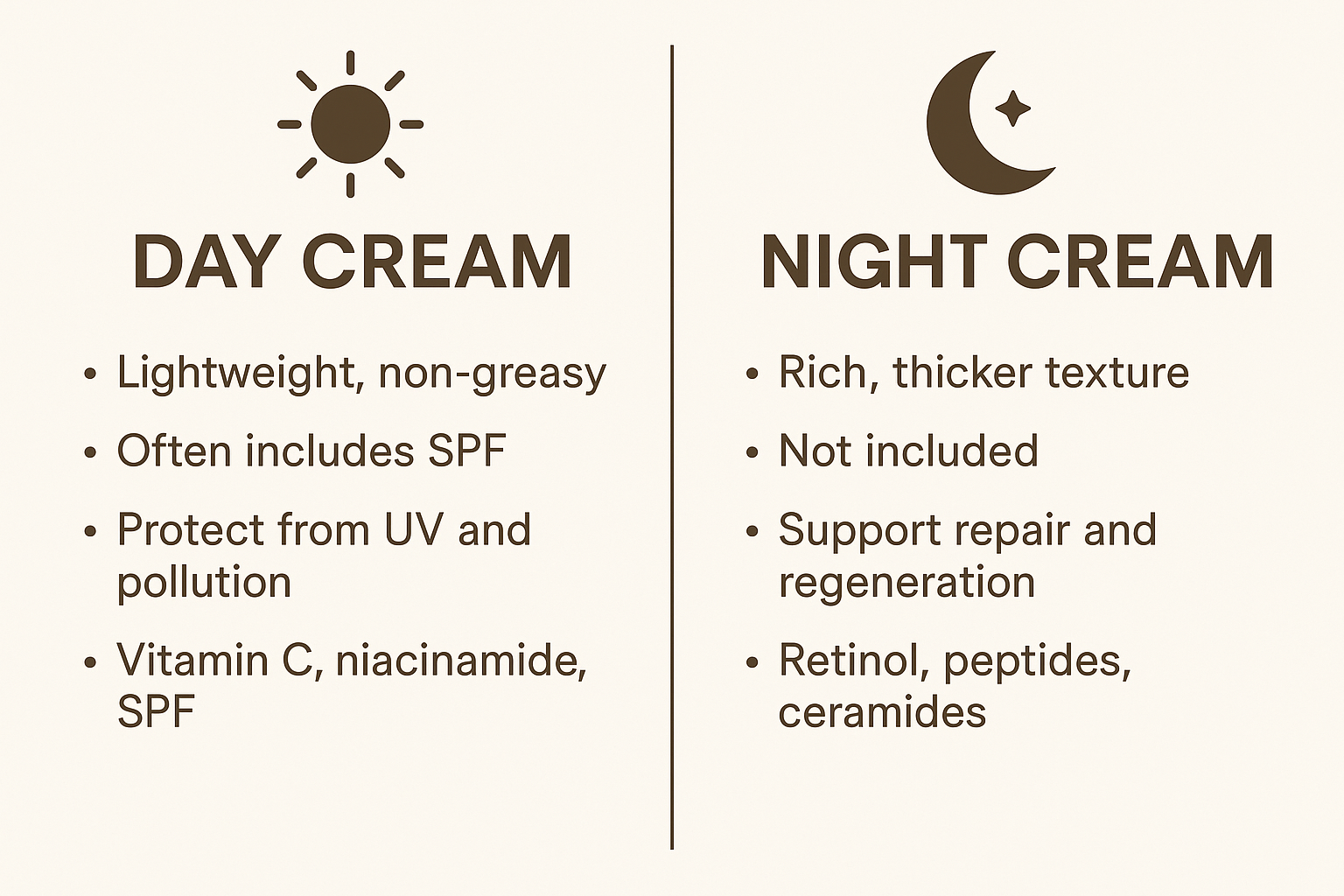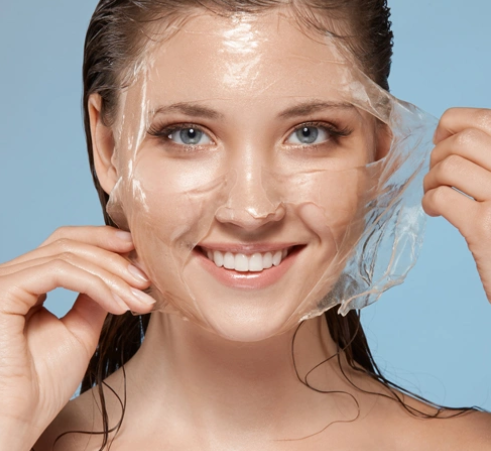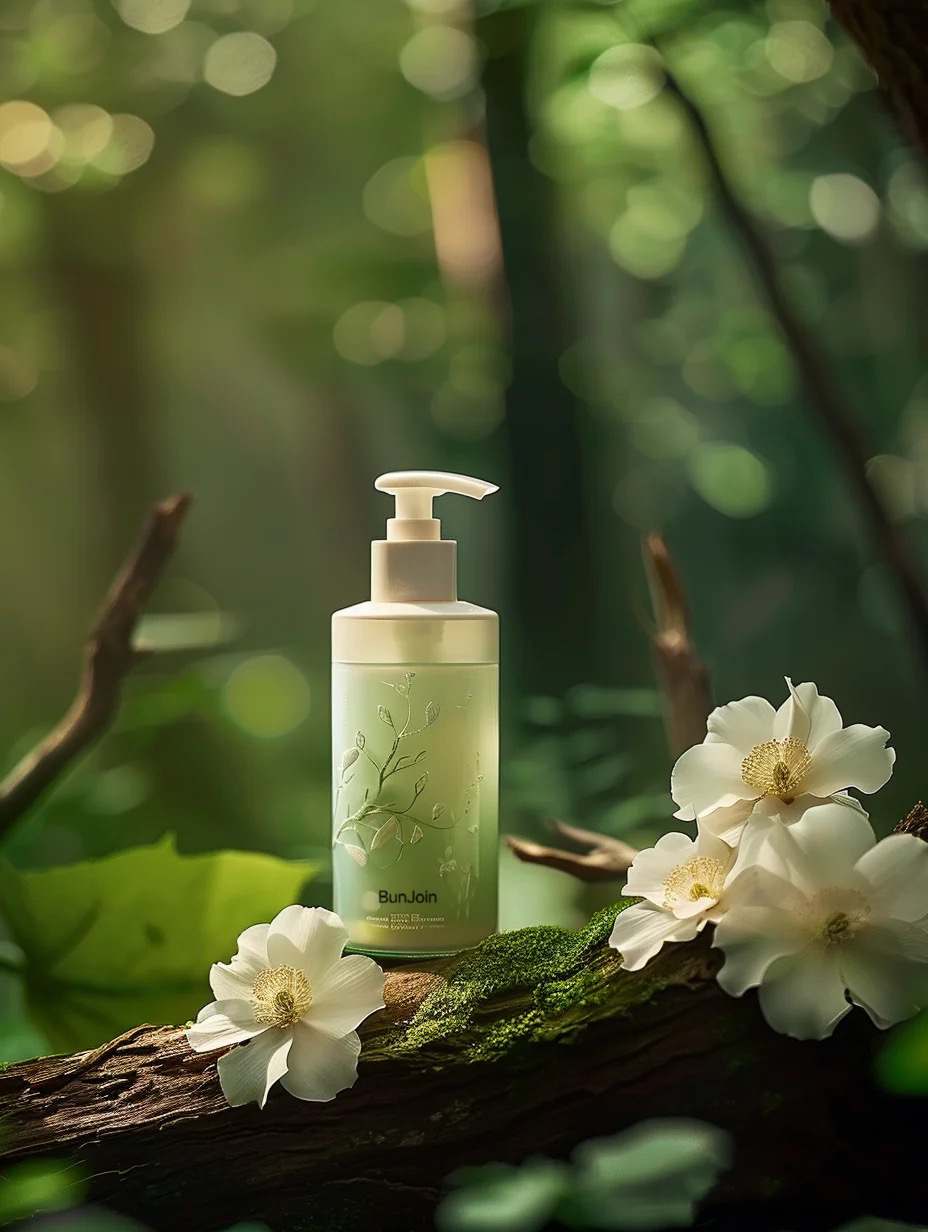What’s the Difference Between Day and Night Creams?
Walk down the skincare aisle or browse an online shop, and you’ll see a wide range of moisturizers — some labeled “day cream”, others as “night cream.” At first glance, they might seem interchangeable. After all, both are moisturizers, right?
Well, not exactly.
While both products are designed to hydrate and nourish your skin, day and night creams serve different purposes and contain different ingredients to match your skin’s changing needs throughout the day and night.
In this article, we’ll explain the key differences, when and how to use them, and whether you really need both in your skincare routine.
Why Your Skin Needs Different Care During the Day and Night
Your skin isn’t static. It goes through natural cycles during the day and night:
☀️ Daytime:
-
Exposed to sun, pollution, sweat, and makeup
-
Needs protection and oil control
-
Must work well under sunscreen or foundation
🌙 Nighttime:
-
Skin enters repair and regeneration mode
-
Cells renew faster during sleep
-
Skin may lose more moisture overnight
Because of these biological changes, using the right type of cream at the right time helps your skin perform better and stay healthier.
What is a Day Cream?
✅ Main Purpose: Protection + Hydration
Day creams are designed to protect your skin from external stressors like UV rays, pollution, and free radicals while keeping it hydrated and comfortable throughout the day.
💡 Typical Features of Day Creams:
-
Lightweight texture: Absorbs quickly and won’t feel greasy under makeup or sunscreen
-
SPF protection: Many contain sunscreen to protect from UV damage
-
Antioxidants: Ingredients like vitamin C or green tea to neutralize free radicals
-
Oil-control agents: Help reduce shine, especially for oily skin
✨ Common Ingredients:
-
Hyaluronic acid – lightweight hydration
-
Niacinamide – brightening and oil control
-
Vitamin C – antioxidant and skin tone evenness
-
SPF filters – such as zinc oxide or avobenzone
What is a Night Cream?
✅ Main Purpose: Repair + Deep Nourishment
Night creams focus on helping your skin recover, repair, and rebuild while you sleep. They are often richer and more concentrated, designed to penetrate deeply and support the skin’s overnight healing process.
💡 Typical Features of Night Creams:
-
Thicker texture: Provides intense hydration for overnight moisture loss
-
No SPF: Not needed at night
-
Anti-aging actives: Stimulate collagen and cell renewal
-
Calming ingredients: Help reduce inflammation and redness
✨ Common Ingredients:
-
Retinol or bakuchiol – boosts cell turnover, smooths fine lines
-
Peptides – support collagen production
-
Ceramides – restore skin barrier
-
Shea butter or squalane – deeply moisturize dry skin
Side-by-Side Comparison
| Feature | Day Cream | Night Cream |
|---|---|---|
| Texture | Lightweight, non-greasy | Rich, thicker |
| SPF | Often included | Not included |
| Key Function | Protect from UV and pollution | Support repair and regeneration |
| Active Ingredients | Vitamin C, niacinamide, SPF | Retinol, peptides, ceramides |
| Best Time to Use | Morning, before SPF or makeup | Night, after cleansing and toning |
Can You Use Just One for Both Day and Night?
You can, but you may not get the full benefit.
If you’re:
-
On a budget or want a simpler routine:
Use a lightweight, fragrance-free moisturizer during the day with added SPF, and a slightly richer one at night. -
Dealing with specific concerns (like wrinkles, pigmentation, or dryness):
Using both a dedicated day and night cream is worth it, as they are formulated for different functions.
How to Use Day and Night Creams Correctly
✅ Day Routine:
-
Cleanser
-
Toner (optional)
-
Day cream
-
Sunscreen
-
Makeup (if you wear it)
✅ Night Routine:
-
Cleanser
-
Exfoliate or toner (if needed)
-
Serum (optional)
-
Night cream
-
Eye cream or treatment (optional)
Tips for Choosing the Right Creams for Your Skin Type
🧴 Oily or Acne-Prone Skin:
-
Day cream: Lightweight, oil-free, mattifying
-
Night cream: Gel-based, with niacinamide or salicylic acid
🧴 Dry or Dehydrated Skin:
-
Day cream: With hyaluronic acid and SPF
-
Night cream: Rich, with ceramides or shea butter
🧴 Sensitive Skin:
-
Avoid fragrance and alcohol
-
Look for soothing ingredients like aloe vera or oat extract
🧴 Aging Skin:
-
Day cream: With antioxidants (vitamin C) and SPF
-
Night cream: With peptides, retinol, or bakuchiol
Common Myths Debunked
❌ “Night cream is just a heavier day cream.”
Not true. Night creams are formulated with different active ingredients that work during skin’s repair phase.
❌ “If I wear sunscreen, I don’t need day cream.”
Sunscreen protects from UV, but day cream offers hydration + antioxidants, which sunscreen doesn’t provide.
❌ “Men don’t need different creams.”
Skin biology is the same — regardless of gender. Men can also benefit from the specific functions of both.
Conclusion
Day and night creams may look similar on the surface, but they serve very different purposes. Think of them like your morning coffee and your nighttime tea — each has a specific role in helping your body (and skin) function better.
If you want radiant, healthy, and youthful-looking skin, choosing the right cream for the right time of day is a simple but powerful step.




